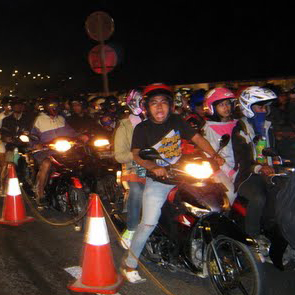
By international standards, Surabaya has an extremely high mode share of private motorized trips (predominantly motorcycle) relative to per capita incomes, despite the fact that average trip distances “as the crow flies” are extremely short.
Non-motorized trips are nonetheless a critical part of the transportation system, while collective forms of transport are much less important than in other regional cities of similar income and density. Motorized travel speeds are currently high for a central urban area, indicating a relatively efficient long distance travel system. Short distance travel, by contrast, is quite inefficient, as indicated by exceptionally high detour factors for short urban trips (under 3km).
This is due primarily to the one-way traffic system, but complicated by the weak secondary street network, safety problems on the main arterials, and lack of infrastructure for non-motorized traffic. Access problems resulting from inhibited short to medium distance trips are addressed somewhat by the presence of vendors along major arterials, greatly improving access for small commodities, but creating conflicts with both motorized and non-motorized traffic flow in some locations.
However, even low income people are forced to use motorized travel even for extremely short trips, leading to conditions where the working poor spend an estimated 20% of their household income on transport. Improved conditions for non-motorized travel in the study area would yield $250,000 in benefits to these low income families each year. The vehicles they rely on, predominantly two-stroke engine motorcycles, are also extremely polluting.
If the modal split for trips under 3km just in the two study areas in Surabaya were brought to the same level of non-motorized trips as in Germany, CO2 emissions could be reduced by 680 tons per year. Reducing the reliance of the poor on motorized travel, meanwhile, would reduce political resistance to tighter tailpipe emission standards and the removal of oil subsidies.
Finally, even with available data, Surabaya has one of the most unsafe traffic systems in the world, and the data is underestimating deaths and dramatically underestimating accidents. The one-way system creates extremely wide roads with no traffic islands, making it extremely difficult for pedestrians to cross safely. Heavily obstructed sidewalks or lack of sidewalks, very poor visibility at night, the absence of any traffic calming measures, the lack of traffic lights particularly for left-turning vehicles, and the high traffic speeds also contribute to extremely unsafe conditions which are inhibiting travel.
Design features of a non-motorized transportation network in the two pilot areas are suggested and partially developed. These design features would facilitate safe non-motorized trips in two-directions on both sides of one-way arterials, greatly reducing detour factors and hence vehicle kilometers traveled between short to medium distance origins and destinations. Extremely modest widening of some kampung streets in some strategic locations would also make possible the reduction of detour factors and the bypassing of major arterials for some trips. These interventions would also encourage a shift from motorized trips with low capacity/flow ratios and high levels of emissions to pedestrian and bicycle trips with much higher capacity flow ratios and no emissions.
Measures to improve pedestrian and non-motorized vehicle (NMV) users safety are also proposed. If the one-way system is to be retained, traffic islands for pedestrian protection are necessary both at intersections and points of heavy NMT crossing activity mid-block. Increasing the number of signalized intersections, and introducing a phase which stops left-turning vehicles to allow NMT to cross is also critical. Improving street lighting at pedestrian crossings, and raising the pedestrian cross-walks is also suggested.